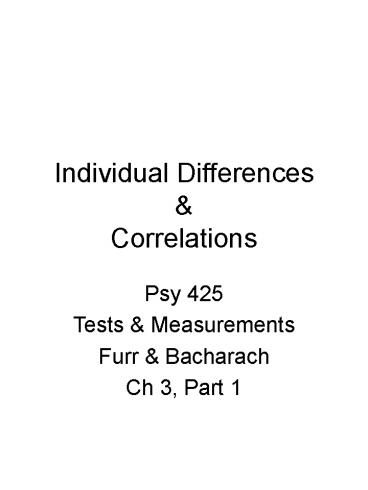Individual Differences - PowerPoint PPT Presentation
Title:
Individual Differences
Description:
Individual Differences & Correlations Psy 425 Tests & Measurements Furr & Bacharach Ch 3, Part 1 Nature of Variability Assumption: Differences exist among people A ... – PowerPoint PPT presentation
Number of Views:142
Avg rating:3.0/5.0
Title: Individual Differences
1
Individual DifferencesCorrelations
- Psy 425
- Tests Measurements
- Furr Bacharach
- Ch 3, Part 1
2
Nature of Variability
- Assumption
- Differences exist among people
- A diagnostic measure is capable of detecting
those differences - Two kinds of differences
- Interindividual (between people)
- Intraindividual (within a single person)
3
Questions
- Who will be admitted?
- Who will benefit?
- Who should be hired?
- Who meets criteria for diagnosis?
4
Crucial assumption
- Psychological differences exist
- AND
- the differences can be detected through
well-designed measurement processes
5
Psychometric Conceptsof Reliability Validity
- Are entirely dependent on differences among
people
6
Individual Differences Psychological Tests
- Research
- Exposing people to different experimental
conditions (experiences) measuring effects of
these conditions on behavior - Determine the extent to which differences are a
function of experimental conditions - Clinical settings
- Diagnosis
- Change over time
7
Variability
- Differences among the scores within a
distribution of scores
8
Assessment of Test Scores
- For a single test
- Detect and describe individual differences within
the distribution of scores - Central tendency
- Variability
- Shape of the distribution
9
TEST SCORES
10
Central Tendency
- typical score in a distribution of scores
- Mean
- Arithmetic Mean
11
MEAN
12
MEAN
13
Variability
- Variance
- Standard Deviation
14
Computing Variance
15
MEAN ? VARIANCE
Mean 17.17
16
DEVIATION
(X X) 1? 9 17.17 -8.17 2? 26 17.17
8.83 3? . . . . . .
Mean 17.17
17
Squared Deviation
SS S(X - X)2 Variance (s2) Standard
Deviation (s)
18
VARIANCE
856 30
s2
29
SS S(X - X)2 Variance (s2) Standard
Deviation (s)
19
Computing Standard Deviation
20
STDEV
856/30
SS S(X - X)2 Variance (s2) Standard
Deviation (s)
21
Assessing the Distribution of Scores
- Frequency count
- For each score or band of scores, count the
number of individuals who received that score or
who are within that band of scores - Plot the frequency distribution of scores
- Ideal distribution?
- Normal theoretically ideal
- What do you usually get?
22
Types of Distributions
- Normal
- Symmetric on either side of the mean
- For psychological tests,
- Often assume that scores are normally distributed
- Important assumption
- Skewed
23
Distribution (2 wide)
Number of Participants
24
Distribution (5 wide)
Number of Participants
25
Normal Distribution
Number of Participants
26
Other Examples
27
Worksheet 1
- Enter scores
- Determine central tendency and variability
- Graph frequency distribution of scores
28
Association between Distributions
- Covariability
- Degree to which two distributions of scores vary
in a corresponding manner - What scores might co-vary?
- Depression anxiety
- Schizotypy autism
- IQ GPA
29
TEST SCORES
30
What do you want to know about these scores?
31
Direction Magnitude
32
Direction of Relationship
- Positive or direct association
- High on one, high on the other
- Negative or inverse association
- High on one, low on the other
33
Magnitude of Relationship
- Strong or weak association?
- Strong
- Consistency between variables
- Weak
- Inconsistency between variables
34
LOOK!
35
- For each test
- Central tendency
- Variability
36
Covariance Correlation
37
(No Transcript)
38
(No Transcript)
39
(No Transcript)
40
(No Transcript)
41
Covariance
- Useful
- Direction of association
- Positive
- Negative
- Limited information
- Magnitude?
- Size of covariance effected by size of scales
- Covariance between two small scale variables
different than that between two large scale
variables
42
Covariance
43
Correlation
- INDEX OF CONSISTENCY OF INDIVIDUAL DIFFERENCE
SCORES - Easy to interpret
- Range between -1.0 and 1.0
- Reflects direction and magnitude of association
- Bounded quality is obtained by dividing the
covariance by the standard deviations of the two
variables.
44
Correlation
45
Worksheet 2
- Enter scores
- Determine central tendency and variability
- Determine cross-products
- Determine covariance
- Determine correlation










![[PDF] Handbook of Individual Differences in Social Behavior 1st Edition Kindle PowerPoint PPT Presentation](https://s3.amazonaws.com/images.powershow.com/10078350.th0.jpg?_=202407130612)




















